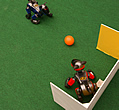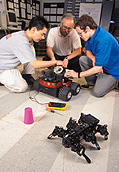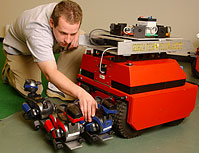Robotics

Dr. Ron Arkin
Atlanta (March 14, 2004) — When most people think of robots, they envision Hollywood images of robots with superhuman powers - oftentimes humanoids with superior intelligence and strength. The reality, however, is quite different from these fantastic visions.
"Humans are very robust systems and very adaptable. I don't see creating robots that compete with humans, but better to create robots that complement and work with humans, not replace them," says Ron Arkin, Regents' professor in the College of Computing at Georgia Tech and director of the Mobile Robot Laboratory.
Over the next 10 years, people will see more robots in their daily lives, and personal robots will become mainstream for household tasks and entertainment. While robotic lawn mowers and vacuum cleaners already exist today, they will become better, more reliable, and more prevalent. Entertainment robots, like the Sony AIBO dog and tour guides, will be more visible as well.

The military will also use more robotic systems. Examples of robotic systems already in use by the military are cruise missiles and unmanned aerial vehicles. Although the U.S. Department of Defense (DoD) has funded much of robotics research, many of the advances gained are applicable for non-military use as well. The long-term goal is for robots to perform such dangerous jobs as disposing of hazardous waste, handling explosives, and clearing mines.
Arkin and Tucker Balch, assistant professor in the College of Computing at Georgia Tech and a founder of the BORG Lab, are scientists creating the next generation of intelligent robots. Their robots range in size and capabilities. For example, Arkin's lab includes a robotic Hummer, and Balch's lab houses a pack of robotic dogs.

Dr. Tucker Balch
Robotic Teams Ranging from Soccer to Military Missions
A growing trend in robotics is designing teams of robots to work together to accomplish tasks ranging from playing soccer to completing military missions. Arkin and Balch envision teams of robots designed for specialized tasks working together—each with its own strengths and weaknesses—to solve problems. Designing large-scale, multi-agent (an agent can be a robot or a human) systems requires cooperation, communication, diversity of agents, shared learning, and shared planning, which presents many interesting research challenges.
"A great challenge to robots on a soccer team is what to communicate and when. If the individual agents communicate all the time about everything, it creates a cacophony of noise. So, our research is focused on what to communicate when, to have the most effective system," says Balch.
In 2003, Balch led a Georgia Tech student team competing in the Robocup American Open Soccer Competition. This has an excellent real-world application because the robotic soccer players must think in real-time in an adversarial environment and model opponents' strategy. Advances resulting from this type of adversarial competition can translate to potential military application-an example of robotic research going from non-military to military.

Dr. Ron Arkin
The Georgia Tech Mobile Robot Laboratory, led by Arkin, specializes in intelligent behavior-based control and hybrid software architectures-blending reasoning with simple reflexive behavioral responses. This lab's approach is unique in that they design robotic systems to react and plan.
"Some of our robots operate on what I call the principle of 'just do it'—you don't think about it, you just react and do it. But in many cases, we feel that's inadequate to achieve the type of high-level performance robotic systems that we'd like to have. So we have to create the ability for the robot to deliberate and to make plans effectively. It's our lab's contention that both of these components are necessary. This initially distinguished us from other laboratory groups around the world, where some believed it's mostly reasoning and others believed it's mostly low-level reactivity. We have a firm commitment to both reacting and planning and figuring out the best ways to get these two systems to work together," says Arkin.
This lab group also develops user-centered robotic systems and is concerned with creating hardware and software to be used in the real world-that doesn't require a Ph.D. to operate. The Mobile Robot Lab frequently conducts usability studies for DoD; however, the lab only does unclassified military research.
The Mobile Robot Lab is currently working on two main software projects funded by DoD. They are working on the Mobile Autonomous Robot Software (MARS) Program for adaptation and learning using a wide range of reinforcement learning algorithms, case-based reasoning, and probabilistic methods to make their robotic system perform well and adapt as well.

Dr. Ron Arkin
For the newer MARS Vision 2020 Program, Arkin's lab is working jointly with the University of Pennsylvania, the University of Southern California, and BBN Technologies. The Vision 2020 Program involves a team of air and ground vehicles that will operate in an urban environment, and they are testing the system at a military urban terrain test facility at Fort Benning, Ga. Georgia Tech is providing the communications-sensitive planning, communications-sensitive behaviors, and communications-recovery behaviors as part of the overall mission. In addition, the Mission Lab software from Arkin's lab is being used as the main operator console for this particular mission. In response to the changing nature of war as seen recently in Afghanistan and Iraq, the military is now investing heavily in the development of robotic systems for urban environments.

Dr. Tucker Balch
Animals as Biological Models
Computer science has a long tradition of borrowing from nature, and using biological models for technology is called biomimetics. As part of his research in multi-agent systems, Balch likes to look to nature for successful examples and sees biology as a library of possible solutions. Balch studies ants to get ideas of how a large colony works together for the good of the whole.
"Nature can provide inspiration for new, efficient ways of doing things. For example, with social insects like ants, an individual ant doesn't exhibit much intelligence, but a colony of thousands of ants is adaptive and acts with great intelligence," says Balch.
In an insect colony or a multi-agent robotic system, effective communications is a huge concern. Questions include: how to communicate effectively, what and when to communicate, and what role each agent plays. To better understand how ants communicate, Balch has tracked ant movements over long periods of time in order to develop models based on these seemingly random movements that can be transferred to robotic systems. Another of Balch's projects involves bees.

Dr. Tucker Balch
According to Arkin, such models have been developed of frogs and amphibians for navigation systems. In the mid-1990s Arkin worked on a National Science Foundation-sponsored project with Instituto Tecnologico Autonomo de Mexico (ITAM) in Mexico City, where they created models based on praying mantis behavior for visual and motor control systems using a behavioral-control model called schema theory. Schema theory provides a common language for biologists and roboticists. The team then imported this praying mantis-based application into a six-legged robot, a hexapod, resulting in realistic behavior by the hexapod depending on whether it saw a prey, a predator, or a mate. If the hexapod saw a predator, he remained motionless, but he moved toward the prey if no predators were present, in a sense like a real praying mantis behaves.
Also, in his independent consulting work with Sony, Arkin works on an animal behavior-based architecture for Sony's AIBO based on studies of canine behavior, the first commercially successful entertainment robot that mimics the behavior of a pet dog.

Dr. Ron Arkin
Future Challenges
Reliability has been and continues to be the biggest obstacle to robots today. Reliability is vastly improved but continues to challenge researchers.
"Our goal is to have robots operate reliably day in and day out, much like a car does, but today's robots aren't there yet," says Balch. "Reliability is a great challenge in the sense that it's currently the biggest impediment to success in robots. From an intellectual point of view, reliability is a plain, ordinary problem, but it's something we have to get past in the short term."
In the past the limitations of power systems and batteries, lack of robust communication systems, and poor reliability limited progress in robotics. However, today, those areas have improved to the point that dramatic improvements in the software or "artificial intelligence" running robots are beginning to appear.
The biggest long-term challenges facing robotics today range from the seemingly simple to the incredibly complex. One ongoing difficulty is getting robots to reliably perceive the world around them with sensors. For example, robots see above-ground obstacles easily but negative obstacles like a hole poorly, and shadows sometimes cause problems as well. Limited perception is a chronic challenge to designing robotic systems to explore and operate in the outside world where lighting and terrain vary considerably. Several research groups at Georgia Tech are working on this problem.
Another long-term challenge is representing human-level intelligence effectively so that computers or robots can truly think, learn, anticipate, plan, and act intelligently.

Dr. Tucker Balch
"The biggest long-term challenge is representing intelligence effectively so that a robot can be intelligent. We are chinking away at this problem step by step, but we haven't discovered the holy grail of intelligence. I think robotics holds the most promise as the domain where we might find this. However, we only know of intelligence in people, and people are different from computers since we live and breathe in the world. Computers are a disembodied intelligence with a screen and a keyboard, whereas robots face the same challenges that we do in that they have to understand and get around in the world. So, I think we'll first see real human-level intelligence evolve in the context of robotic systems," says Balch.
Systems integration — getting the independent component technologies of perception, control, actuation, mechanical design, and user interfaces to work together — is another long-term challenge to making a usable, useful robotic system that can make a difference in our everyday lives.
With plenty of room for improvements, roboticists see a future full of exciting discoveries. Arkin says robotics is currently at the toddler stage, not even at adolescence yet. So, for those bright young students who like math and science and dream of one day creating robots like they see in the movies, the future is bright.
Related Links
BORG Lab
www.borg.cc.gatech.edu
Mobile Robot Laboratory
www.cc.gatech.edu/ai/robot-lab/
Robotics@Georgia Tech
www.robotics.gatech.edu

For more information contact:
Megan McRainey, Communications & Marketing
Contact Megan McRaineymegan.mcrainey@comm.gatech.edu
404-894-6016



